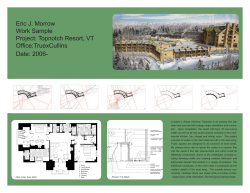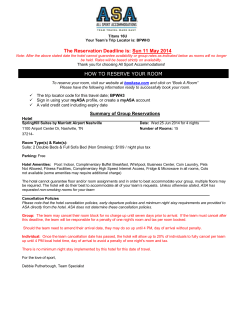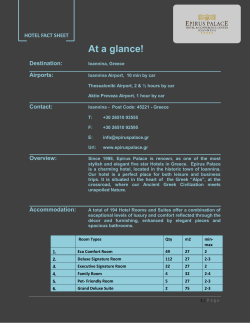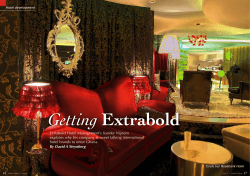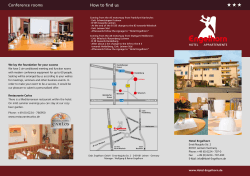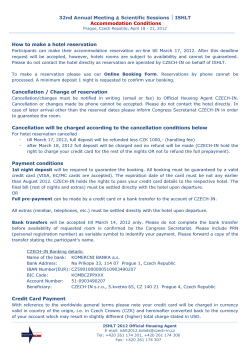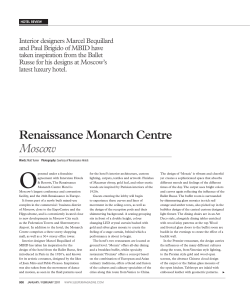
Chapter 10 Chapter 2 The World of Lodging Hotel Classifications
Chapter 2 Hotel Classifications Front Office Operations & Management By Ahmed Ismail Chapter 10 The World of Lodging Hospitality Services : Food & Lodging By: Johnny Sue Reynolds 1 Objective After reading this chapter, you should understand: How hotels are classified . Describe the characteristics of full-service hotels, limitedservice properties, specialty accommodations, and institutional housing. List the three type of hotel ownership. Hotel rating system. 2 Introduction • The hotel pioneers discussed set the groundwork for many of the designs, services, and amenities considered commonplace today. • Criteria for identifying hotels are based on: size location product type 3 Hotel Sizes • The industry use the following to determine a hotel’s size based on its number of rooms. Classification Small Medium Large Mega Number of Sleeping Rooms 1 to 150 151 to 400 401 to 1500 1501 and over 4 • Management salaries increase as the number of guest rooms increase. • A larger hotel will theoretically be harder to manage (due to a larger staff, more outlets, and a greater amount of meeting space). 5 • Larger hotel sizes will also necessitate a greater number of specialized management positions. • A large-size hotel many have a front office manager as well, but reporting to him/her may be the following: (assistant front office managers, front des managers, valet manager, concierge manager, PBX manager, bell captain, parking garage manager, numerous supervisors, and so on). 6 Types of Lodging Businesses 7 • Lodging businesses can be organized into four categories based on level of service: full-service hotels, limited-service properties, specialty accommodations, and institutional housing. • Full-service hotels pride themselves on their high level of service and usually charge the highest prices. • Limited-service properties focus on charging lower prices. Providing fewer services. 8 Specialty accommodations vary in their levels of service, but usually proved less than full-service hotels. Some specially accommodations provide guest rooms with private baths, telephones, and televisions. Institutional housing is provided for people who live in institutions, such as schools, universities, hospitals, prisons, and the military. The names of the properties will include words such as hotel, inn, motel, motor inn, lodge, resort and bed-and-breakfast. 9 Full-Service Hotel • A full-service hotel is large and provides many services. • First distinguish feature is architecture, two or more stories and over 3,000 rooms. • Second distinguish feature level of service. Services may included: luggage assistance, concierge service, one or more restaurants, bars, lounges, room service, meeting/banquet facilities, spa services, and recreational facilities. 10 • A concierge is a hotel staff member who helps guest make arrangements, such as dinner reservations. A concierge also advises guests on what to do and see in the area around the hotel. • Five subcategories of full-service hotels: convention luxury condominium resort extended-stay 11 Convention Hotels • Convention hotel is designed to provide for the special needs of conventions and trade shows. • A convention is a large meeting, usually sponsored by a group for its members. Number of people attending 50 to 50,000. 12 • Trade show is an exhibit during which people who have goods and services to sell show their goods and services. • Exhibit hall is the place where trade shows are held. Must be quite large. • Convention hotels are often located near a convention center. A convention center is locally funded, or privately owned structure that caters to large meetings, conventions and trade shows. 13 McCormick Place in Chicago 14 Luxury Hotels • Luxury hotel provides the highest level of amenities, service, room furnishings, public spaces, and technology. • Provide more services, more personal attention to guests, and more elegance than a typical full-service hotel. 15 Resort Hotels • Resort hotel caters to the vacationer or leisure traveler. • A resort is a place that provides entertainment, recreation, and relaxation for vacationers. • Located near seashores, mountains, and hot springs. 16 17 Extended Stay Hotels • Guests who stay for 5 to 29 days are called extended stay guests. Long-stay guests stay for 30 days or more. Normally these are business people. • The major characteristic of these hotels is that they provide kitchen facilities and more than one room for each accommodation. 18 • A suite is a hotel accommodation that consists of more than one room. • All suite hotels were developed to provide more space at a lower cost. • A suite in these hotels is usually tow hotel rooms joined together. These suites combine living space with kitchen facilities. • Extended-&-long stay suites provide a full kitchen with dishes and utensils. Some have grocery shopping service for guests. • Residential hotels cater to long-stay guests. • The décor is usually more like a home with a kitchen, living area, and bedroom 19 Condominium Hotels • New Condo Hotel Apartments at Manor Park Resort in Hua Hin, Thailand • They offer many amenities. They have multi-room apartments with full kitchens. • Usually individually owned. • Property operated by a management company. • Many new, upscale hotels are being build with condos above them. The owners can use the hotels amenities (room service, housekeeping). 20 Park Hyatt in Chicago 21 Two type of condo ownership: 1. Individual owner. 2. Time-share ownership. A time share owner own the right to use the unit for a specific time of the year. 22 Limited-Service Properties • Limited service property is smaller, provides fewer services, and is less expensive than a full-service hotel. • A motel is distinguished from a hotel by it architecture and level of service. Parking is close to the rooms. Rooms are entered from the outside and minimal services. 23 • Motels offer a room with a bed, t.v.,phone, private bath, and daily housekeeping. • Many motels have begun to offer pools, continental breakfast. • Continental breakfast consists of breakfast foods that do not need to be cooked. 24 Inns refer to smaller hotels. Offer fewer amenities. Limited service properties are organized into two categories: limited service hotels budget hotels 25 Limited-Service Hotels Budget Hotels Limited Service Hotels offer a medium level of service and a midrange price. • Budget hotels have the lowest rate and least amount of service. • Focus on comfortable, clean place to sleep at the lowest rate. Typically have 3 or 4 stories. Has the word Inn in the name, and offers more services than a motel but fewer than a hotel. • Motel 6 was the first of it’s kind with room for $6 a night in the 1960s. No restaurant or bell attendant. • Ex.: Microtel is a newer property of this kind. Ex.: LaQuinta Inns, Hampton Inns, Fairfield Inns 26 Specialty Accommodations • Conference center…lodging facility, 60% of occupancy is generated by conference. • Lodges…rooms and housekeeping for guest to participate in recreational activities. • Bed & Breakfast…private home offering one or more guest rooms. • Hostels…an inexpensive place to stay rooms, kitchen, and bath are shared. No linen or toiletries. • Campgrounds…located in natural environment. 27 Institutional Housing • • • • Dorms Hospitals Prisons Senior housing 28 Ownership & Management 29 Classified by the types of ownership: independent, chains, franchises Independent lodging property is a single-unit business not connected with any other business. Usually one owner. The owner could be a single person, a partnership, or a corporation. 30 Hotel Chains • Chains are multiple-unit businesses that have the same brand name and the same ownership. • A franchise is a unit of a chain that has been purchased by an outside owner. The outside owner runts the franchise in the way required by the chain owner. 31 • Advantages of chains in brand name. • The chain owner also work to develop brand loyalty. One way is through frequent guest programs. • Ex.: Whenever you stay at a unit of the chain, you earn points. Like health club privileges or free nights stay. 32 • Central Reservation Center is one office that handles the reservations for all the units in the chain. • A guest can call one toll free number to reserve a room at any hotel in the chain anywhere in the country or the world. 33 Hotel Management • Hotel Management is the day to day running of the hotel. Hotel management is often called hotel operation. • One person (or company) can own the hotel, and another person (or company) can manage it. 34 • As far as customers are concerned, they identify the owner with the brand name on the hotel. 35 Hotel Location Classifications • Hotel location types are classified by physical positioning in relation to the customers in the area and to their tangible locale. • Hotel types/location: Downtown Resorts Airport Suburban Highway 36 Downtown Apply to hotels located in dense urban areas. Traditionally they are located in the center of a city’s business district, near offices an retail stores and close to entertainment center. Hotel Americas Houston, Texas Located next to the George R. Brown Convention Center (GRB) Many are full service. Usually attract business travelers during the week and leisure travelers on the weekends. 37 Suburban • Suburban hotels developed because businesses moved to the suburbs. • Accommodations were needed for business meetings, conventions, and individual business travelers and social events. La Quinta Hotel Kingwood, Texas 38 Highway As the highway system developed, the demand for lodging along the highways developed. Most accommodations along with highways are limited-service hotels and budget hotels. 39 Airport • This is the easiest one to identify. • The airport is the special attraction. • Commonly provided complimentary shuttle service to and from the airport to make it easy for the traveler. Hours for the restaurants, lounges, and other facilities may be longer to accommodate travelers. • Multilingual staff a common to assist international travelers. 40 • Gateway cities are traditionally those located in an area that make them the first practical stop for an international flight coming into a country. • In the USA, Seattle, San Francisco, & LA are gateways for Asia and the far East. • NY, Boston, & Washington are gateways to Europe and beyond. • Miami is gateway to South America. • Improvements in airplane technology are allowing for longer direct flights from cities not commonly considered gateways (Chicago, Minneapolis & Atlanta) are good examples. 41 Resort • Resort can be located near some sort of special attraction that attracts guests for a reason other than the hotel itself. An ocean, natural wonder, mountain, amusement park, or golf course can be that attraction. • Hotel that create their own special attraction can also be considered resorts. Health spas, private gold and/or tennis facilities, expansive poor areas, and other unique signature attractions created by the hotel itself allow for the resort location classification. Half Moon Bay Resort in Montego Bay Jamaica 42 Service Level • A hotel’s service level is measured by the amount of actual and perceived consideration a guest can reasonably expect to receive. • A consumer perceives a value in receiving quality service. • In the hotel industry, the differences in service levels is often (but not always) tied to incremental increases in cost. 43 Full-service hotels, by definition, provide their guest with services, amenities and facilities that they want or need to complete a total hotel experience. Service include but not limited to: restaurant(s) meeting space health club/rec. facility room service business center bell staff Limited service hotels typically do not offer the above services. The most notable differences are lack of food or beverage outlets and no meeting space. 44 Target Market • A target market is the market segment the lodging business focuses on. • Market Segments: business convention/meeting long-stay leisure budget special 45 Independent Hotel Ratings • A star system is primarily used to denote the level of quality and service, with one star being the lowest and five stars being the highest level. • International travelers can be reasonably confident about what to expect by using these stars as a guide. • The criteria by which each hotel is judged may vary from country to country. 46 • In the United States, the government does not play any role in classifying hotel. This is left up to independent organizations. • Magazines, associations and other special interest groups issue ratings based on their won criteria. 47 Lodging & Food Service 48 • Food & beverage is an essential part of the lodging’s service in the lodging properties. • Many have restaurant (casual & fine dining), snack shops, room service, and cocktail lounges. • Limited service properties often offer a continental breakfast and coffee in the lobby. 49 • A room rate that includes meals is called a meal plan. • Types of meal plan: Full American…3 meals a day Modified American…2 meals (breakfast & dinner) Continental …breakfast that does not have to be cooked European…no meals 50 Lodging Concepts 51 • Lodging concept is the whole idea of the lodging property or chain. This includes the theme, target market, décor, ambiance, and level of service. • Ex.: End of the Line Vacation Station in Lake Geneva, Wisconsin, guests can spend the night in an old caboose or in a Pullman-car suite. 52
© Copyright 2025
